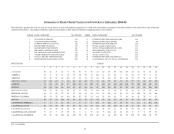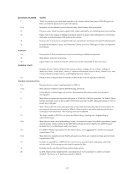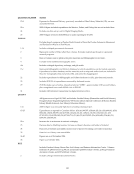98
Include government document volumes that are accessible through the library’s catalogs regardless of whether they
are separately shelved. “Classified” includes documents arranged by Superintendent of Documents, CODOC, or
similar numbers. “Cataloged” includes documents for which records are provided by the library or downloaded
from other sources into the library’s card or online catalogs. Documents should, to the extent possible, be counted
as they would if they were in bound volumes (e.g., 12 issues of an annual serial would be one or two volumes).
Title and piece counts should not be considered the same as volume counts. If a volume count has not been kept, it
may be estimated through sampling a representative group of title records and determining the corresponding
number of volumes, then extrapolating to the rest of the collection. As an alternative, an estimate may be made
using the following formulae:
52 documents pieces per foot
10 “traditional” volumes per foot
5.2 documents pieces per volume
Include e-book units, as long as these e-books have been purchased and are owned by your library. If you have
access to netLibrary titles as a result of participating in various consortia, do not report these e-books as your
library's property unless the e-books actually belong to your library. If the books were purchased by a consortium,
they may belong to the consortium itself and not to the participating libraries. Report only the number of e-books
that belong to your library and are cataloged, classified and made ready for use. Provide a footnote explaining how
many e-books you are reporting, preferably by specifying the products and the number of titles in a note.
For information on how to count items housed in remote storage, see the Interim Guidelines for Counting Materials
Housed in Library Storage Centers, at http://www.arl.org/stats/arlstat/storage.html .
If either formulas or sampling are used for deriving your count, please indicate in a footnote.
Question 1b. Volumes Added. Include only volumes cataloged, classified, and made ready for use. Include
government documents if they have been included in the count of volumes on line 1a. Do not include as part of
Volumes Added Gross any government documents or other collections (large gift collections or e-book packages)
that were added to the collection as the result of a one time download or addition to the OPAC. Include these items
in Volumes Held of the previous year (Line 1a) and provide a footnote explaining the revision of Line 1a.
Include e-book units, as long as these e-books have been purchased and are owned by your library. If you have
access to netLibrary titles as a result of participating in various consortia, do not report these e-books as your
library's property unless the e-books actually belong to your library. If the books were purchased by a consortium,
they may belong to the consortium itself and not to the participating libraries. Report only the number of e-books
that belong to your library and are cataloged, classified and made ready for use. Provide a footnote explaining how
many e-books you are reporting, preferably by specifying the products and the number of titles in a note.
Question 2. Monographic Volumes Purchased. Report number of volumes purchased do not include volumes
received or cataloged. Include all volumes for which an expenditure was made during 2004-05, including volumes
paid for in advance but not received during the fiscal year. Include monographs in series and continuations. Include
e-books that fit the netLibrary model, i.e., electronic manifestations of physical entities and/or units provide a
footnote explaining how many e-books you are reporting, preferably by specifying the products and the number of
titles. If only number of titles purchased can be reported, please report the data and provide an explanatory footnote.
Question 3: Basis of Volume Count. A physical count is a piece count a bibliographic count is a catalog record
count.
Questions 4-5. Serials. Report the total number of subscriptions, not titles. Include duplicate subscriptions and, to
the extent possible, all government document serials even if housed in a separate documents collection. Verify the
inclusion or exclusion of document serials in Question 5. Exclude unnumbered monographic and publishers’ series.
Electronic serials acquired as part of an aggregated package (e.g., Project MUSE, BioOne, ScienceDirect) should be
counted by title. A serial is
Include government document volumes that are accessible through the library’s catalogs regardless of whether they
are separately shelved. “Classified” includes documents arranged by Superintendent of Documents, CODOC, or
similar numbers. “Cataloged” includes documents for which records are provided by the library or downloaded
from other sources into the library’s card or online catalogs. Documents should, to the extent possible, be counted
as they would if they were in bound volumes (e.g., 12 issues of an annual serial would be one or two volumes).
Title and piece counts should not be considered the same as volume counts. If a volume count has not been kept, it
may be estimated through sampling a representative group of title records and determining the corresponding
number of volumes, then extrapolating to the rest of the collection. As an alternative, an estimate may be made
using the following formulae:
52 documents pieces per foot
10 “traditional” volumes per foot
5.2 documents pieces per volume
Include e-book units, as long as these e-books have been purchased and are owned by your library. If you have
access to netLibrary titles as a result of participating in various consortia, do not report these e-books as your
library's property unless the e-books actually belong to your library. If the books were purchased by a consortium,
they may belong to the consortium itself and not to the participating libraries. Report only the number of e-books
that belong to your library and are cataloged, classified and made ready for use. Provide a footnote explaining how
many e-books you are reporting, preferably by specifying the products and the number of titles in a note.
For information on how to count items housed in remote storage, see the Interim Guidelines for Counting Materials
Housed in Library Storage Centers, at http://www.arl.org/stats/arlstat/storage.html .
If either formulas or sampling are used for deriving your count, please indicate in a footnote.
Question 1b. Volumes Added. Include only volumes cataloged, classified, and made ready for use. Include
government documents if they have been included in the count of volumes on line 1a. Do not include as part of
Volumes Added Gross any government documents or other collections (large gift collections or e-book packages)
that were added to the collection as the result of a one time download or addition to the OPAC. Include these items
in Volumes Held of the previous year (Line 1a) and provide a footnote explaining the revision of Line 1a.
Include e-book units, as long as these e-books have been purchased and are owned by your library. If you have
access to netLibrary titles as a result of participating in various consortia, do not report these e-books as your
library's property unless the e-books actually belong to your library. If the books were purchased by a consortium,
they may belong to the consortium itself and not to the participating libraries. Report only the number of e-books
that belong to your library and are cataloged, classified and made ready for use. Provide a footnote explaining how
many e-books you are reporting, preferably by specifying the products and the number of titles in a note.
Question 2. Monographic Volumes Purchased. Report number of volumes purchased do not include volumes
received or cataloged. Include all volumes for which an expenditure was made during 2004-05, including volumes
paid for in advance but not received during the fiscal year. Include monographs in series and continuations. Include
e-books that fit the netLibrary model, i.e., electronic manifestations of physical entities and/or units provide a
footnote explaining how many e-books you are reporting, preferably by specifying the products and the number of
titles. If only number of titles purchased can be reported, please report the data and provide an explanatory footnote.
Question 3: Basis of Volume Count. A physical count is a piece count a bibliographic count is a catalog record
count.
Questions 4-5. Serials. Report the total number of subscriptions, not titles. Include duplicate subscriptions and, to
the extent possible, all government document serials even if housed in a separate documents collection. Verify the
inclusion or exclusion of document serials in Question 5. Exclude unnumbered monographic and publishers’ series.
Electronic serials acquired as part of an aggregated package (e.g., Project MUSE, BioOne, ScienceDirect) should be
counted by title. A serial is


















































































































































